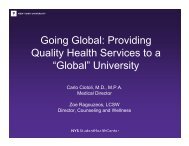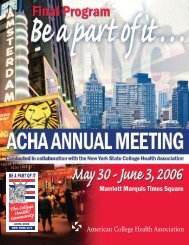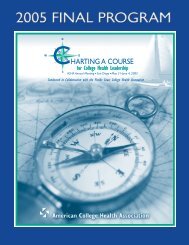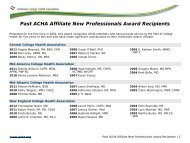Pap Test and STI Survey - American College Health Association
Pap Test and STI Survey - American College Health Association
Pap Test and STI Survey - American College Health Association
Create successful ePaper yourself
Turn your PDF publications into a flip-book with our unique Google optimized e-Paper software.
<strong>American</strong> <strong>College</strong> <strong>Health</strong> <strong>Association</strong><br />
<strong>Pap</strong> <strong>Test</strong> <strong>and</strong> <strong>STI</strong> <strong>Survey</strong> for Calendar Year 2011<br />
Thank you for taking the time to complete this survey. The ACHA Sexual <strong>Health</strong> Education <strong>and</strong> Clinical Care Coalition<br />
recently updated the survey to make it as concise <strong>and</strong> easy-to-follow as possible. The objective of this survey is to<br />
track modes of management <strong>and</strong> outcomes of evaluation to serve as both a benchmark <strong>and</strong> database of comparable<br />
statistics. Please submit only objective data except as specified. Please leave blank unanswerable questions<br />
or questions that are not applicable to your health services. Enter 0 if the answer is actually numerically<br />
zero. Do not use commas in your numerical entries. DEADLINE: May 31, 2012.<br />
NOTE: PLEASE NAVIGATE WITH THE MOUSE OR PRESS THE TAB KEY AFTER EACH ENTRY. DO NOT USE<br />
THE ENTER KEY.<br />
Please print this survey prior to filling out the online survey <strong>and</strong> use as a worksheet. There are three<br />
separate sections to print out. Submit the completed online survey data one time only. We also encourage<br />
you to use the current survey as a guide while tracking calendar year 2012 data.<br />
1) Name of Institution:<br />
2) Name <strong>and</strong> title of respondent:<br />
3) E-mail address for questions about survey entries:<br />
4) Telephone number of respondent:<br />
5) Is your Student <strong>Health</strong> Service an Institutional Member of ACHA?<br />
Yes<br />
No<br />
Uncertain<br />
6) In which affiliate are you/would you be a member?<br />
Southwest <strong>College</strong> <strong>Health</strong> <strong>Association</strong> (AR, LA, NM, OK, TX; Mexico, Central America, South America)<br />
Southern <strong>College</strong> <strong>Health</strong> <strong>Association</strong> (AL, FL, GA, MS, NC, PR, SC, TN, VI; Africa, Caribbean)<br />
North Central <strong>College</strong> <strong>Health</strong> <strong>Association</strong> (IA, MN, ND, SD, WI; Canadian members in Manitoba <strong>and</strong><br />
Nunavut)<br />
Central <strong>College</strong> <strong>Health</strong> <strong>Association</strong> (KS, MO, NE)<br />
Rocky Mountain <strong>College</strong> <strong>Health</strong> <strong>Association</strong> (CO, MT, WY; Canadian members in Saskatchewan)<br />
Mid-America <strong>College</strong> <strong>Health</strong> <strong>Association</strong> (IL, IN, KY, MI; Canadian members in Ontario)<br />
Ohio <strong>College</strong> <strong>Health</strong> <strong>Association</strong> (OH)<br />
Mid-Atlantic <strong>College</strong> <strong>Health</strong> <strong>Association</strong> (DC, DE, MD, NJ, PA, VA, WV; Greenl<strong>and</strong>, Europe)<br />
New York State <strong>College</strong> <strong>Health</strong> <strong>Association</strong> (NY)<br />
New Engl<strong>and</strong> <strong>College</strong> <strong>Health</strong> <strong>Association</strong> (CT, MA, ME, NH, RI, VT; Canadian members in New Foundl<strong>and</strong> <strong>and</strong><br />
Labrador, New Brunswick, Nova Scotia, Prince Edward Isl<strong>and</strong>, <strong>and</strong> Quebec)<br />
Pacific <strong>College</strong> <strong>Health</strong> <strong>Association</strong> (AK, AZ, CA, HI, ID, NV, OR, UT, WA; Asia, Australia, New Zeal<strong>and</strong>, <strong>and</strong><br />
Canadian members in Alberta, British Columbia, Northwest Territories, <strong>and</strong> the Yukon)<br />
7) Institutional Control:<br />
Public 2-year<br />
Private 2-year<br />
Public 4-year<br />
Private 4-year<br />
8) Campus Location:
Urban >1,000,000 population<br />
Urban 100,000-1,000,000 population<br />
Urban < 100,000 population<br />
Suburban<br />
Rural<br />
Other (please specify)<br />
If you selected other please specify:<br />
9) Current academic year undergraduate student enrollment for your campus:<br />
No undergraduate students<br />
Under 1,000<br />
1,000 to 1,999<br />
2,000 to 4,999<br />
5,000 to 9,999<br />
10,000 to 14,999<br />
15,000 to 19,999<br />
20,000 to 24,999<br />
25,000 to 29,999<br />
30,000 to 39,999<br />
40,000 +<br />
10) Current academic year graduate <strong>and</strong> professional student enrollment for your campus:<br />
No graduate/professional students<br />
Under 1,000<br />
1,000 to 1,999<br />
2,000 to 4,999<br />
5,000 to 9,999<br />
10,000 to 14,999<br />
15,000 to 19,999<br />
20,000 to 24,999<br />
25,000 to 29,999<br />
30,000 to 39,999<br />
40,000 +<br />
11) Special institutional attributes (Check all that apply):<br />
Historically Black <strong>College</strong> or University (HBCU)<br />
Minority Postsecondary Institution (MPI)<br />
Hispanic Serving Institution (HSI)<br />
Tribal <strong>College</strong> <strong>and</strong> University (TCU)<br />
Alaska Native or Native Hawaiian Serving Institution (ANNH)<br />
Faith-based Institution<br />
Community <strong>College</strong><br />
None listed here<br />
Don't Know<br />
12) Which best describes your role in college health?<br />
Administrator<br />
Advanced Practice Clinician<br />
Dietitian or Nutritionist<br />
<strong>Health</strong> Educator<br />
HIM/QI<br />
Laboratorian<br />
Nurse<br />
Nurse Director<br />
Pharmacist<br />
Physician<br />
Psychologist/Mental <strong>Health</strong> Provider<br />
Social Worker<br />
Student Affairs Administrator<br />
Other (please specify)<br />
If you selected other please specify:<br />
13) Institutional demographic information (Do not enter % sign or commas)
Number of students enrolled at institution<br />
Percent female<br />
Total number of student medical visits to your health center in 2011<br />
Percent female visits<br />
Number of student women's health related visits to your health center in 2011<br />
students<br />
percent<br />
visits<br />
percent<br />
visits<br />
14) What percent of women's health visits are conducted by each of the following provider disciplines?<br />
(total should equal approximately 100%; do not enter % sign)<br />
Nurse<br />
Advanced Practice Nurse<br />
Physician Assistant<br />
Gynecologist<br />
Other Physician<br />
Non-Provider Visits<br />
Other<br />
percent<br />
percent<br />
percent<br />
percent<br />
percent<br />
percent<br />
percent<br />
15) If you selected other please specify:<br />
Online <strong>Survey</strong> Software powered by Vovici.
<strong>American</strong> <strong>College</strong> <strong>Health</strong> <strong>Association</strong><br />
<strong>Pap</strong> <strong>Test</strong> <strong>and</strong> <strong>STI</strong> <strong>Survey</strong> for Calendar Year 2011<br />
Cervical Cancer Screening<br />
Assumptions about st<strong>and</strong>ard of care are based on the 2006 "ASCCP Consensus Guidelines for the<br />
Management of Women with Abnormal Cervical Cancer Screening <strong>Test</strong>s" available at the link below.<br />
ASCCP Consensus Guidelines for the Management of Women with Abnormal Cervical Cancer Screening<br />
<strong>Test</strong>s<br />
Guidelines<br />
16) What cervical cytology screening tests do you provide? (check all that apply)<br />
Conventional slide cytology (<strong>Pap</strong>)<br />
Liquid-based cytology, with reflex HPV testing<br />
Liquid-based cytology, without reflex HPV testing<br />
None of these are offered by our health service<br />
17) What cervical disease management modalities are provided in-house? (check all that apply)<br />
Colposcopy<br />
Cervicography<br />
Cryotherapy<br />
Laser ablation<br />
LEEP<br />
None of the above<br />
Other (please specify)<br />
If you selected other please specify:<br />
18) What is your st<strong>and</strong>ard recommendation for when to begin regular <strong>Pap</strong> testing? (check most common<br />
practice)<br />
Three years after first intercourse or age 21, whichever comes first<br />
Age 18<br />
Age 21<br />
At onset of sexual activity<br />
Varies by provider, no st<strong>and</strong>ard practice<br />
The following questions pursue separate, but overlapping lines of inquiry. Question 19 is looking for<br />
results of <strong>Pap</strong> tests performed during the 2011 calendar year. Ideally, these would represent only<br />
screening <strong>Pap</strong>s (as opposed to <strong>Pap</strong>s done to follow up a prior abnormal result on a given patient), but it<br />
is recognized that this level of detail is perhaps beyond the scope of many tracking systems.<br />
19) Summary of all <strong>Pap</strong> test results for January 1, 2011-December 31, 2011 (Results in items Q19B<br />
through Q19J are mutually exclusive <strong>and</strong> SHOULD SUM TO EQUAL THE TOTAL REPORTED in Q19A.<br />
Question 19K is independent of diagnosis <strong>and</strong> should not be included in the sum.) Please make sure to<br />
enter data in both 19A <strong>and</strong> 19B-J below so that we can calculate correct rates for each category of test<br />
result. If you do not have paired data for both the # of tests done <strong>and</strong> the # of results, please leave this<br />
entire question blank.<br />
A. Total number of <strong>Pap</strong> tests done total tests<br />
B. Number reported as normal normal<br />
C. Number reported as ASC-US ASC-US<br />
D. Number reported as ASC-H ASC-H<br />
E. Number reported as LSIL LSIL<br />
F. Number reported as HSIL HSIL<br />
G. Number reported as CIS CIS<br />
H. Number reported as AGC AGC
I. Number reported as unsatisfactory (no dx) unsatisfactory<br />
J. Number reported as other dx, not listed above other<br />
K. Number reported with no endocervical cells present (with any dx above) no endocervical cells<br />
20) What is your usual practice for management of a screening <strong>Pap</strong> test reported as Atypical Squamous<br />
Cell of Undetermined Significance (ASC-US) <strong>Pap</strong> test [hereafter "first ASC-US"]? (check one)<br />
HPV DNA test (reflex or otherwise)<br />
Repeat <strong>Pap</strong> in 4-6 months<br />
Repeat <strong>Pap</strong> in 12 months<br />
Immediate colposcopy<br />
Varies by provider, no st<strong>and</strong>ard practice<br />
EVALUATION OF ASC-US PAPS<br />
21) Evaluation of screening <strong>Pap</strong>s read as Atypical Squamous Cells of Undetermined Significance (ASC-US)<br />
A. Total number of first ASC-US <strong>Pap</strong>s worked-up during 2011 calendar year ASC-US<br />
B. Number of these followed-up with HPV DNA testing HPV DNA<br />
C. Number of these followed-up with repeat cytology repeat<br />
D. Number of these followed-up with colposcopy colposcopy<br />
E. Number of these for which outcome is unknown unknown<br />
F. Number of these followed-up with other modalities other<br />
22) First ASC-US <strong>Pap</strong>s followed-up with HPV DNA testing<br />
A. Number of first ASC-US <strong>Pap</strong>s followed-up with HPV DNA testing HPV DNA<br />
B. Number of these positive for high-risk HPV types positive H-R HPV<br />
23) First ASC-US cases followed-up with repeat cytology in 4-6 months<br />
A. Number of first ASC-US cases followed-up with repeat cytology in 4-6 months repeat<br />
B. Number of these abnormal (greater than or equal to ASC-US) abnormal<br />
Online <strong>Survey</strong> Software powered by Vovici.
<strong>American</strong> <strong>College</strong> <strong>Health</strong> <strong>Association</strong><br />
<strong>Pap</strong> <strong>Test</strong> <strong>and</strong> <strong>STI</strong> <strong>Survey</strong> for Calendar Year 2011<br />
<strong>STI</strong> <strong>Test</strong>ing<br />
24) Do you offer routine <strong>STI</strong> screening for asymptomatic women?<br />
Yes<br />
No<br />
25) Do you offer routine <strong>STI</strong> screening for asymptomatic men?<br />
Yes<br />
No<br />
26) Which of the following tests do you offer for <strong>STI</strong> screening of asymptomatic students, as appropriate<br />
for risk? (check all that apply)<br />
Chlamydia<br />
Gonorrhea<br />
Hepatitis B<br />
Hepatitis C<br />
Herpes<br />
HIV<br />
Syphilis<br />
Trichomoniasis<br />
None of the above<br />
Other (please specify)<br />
If you selected other please specify:<br />
27) Do you routinely screen sexually active women under age 26 for chlamydia infection?<br />
Yes<br />
No<br />
28) What type of specimen do you usually/preferentially collect for chlamydia testing in women? (check<br />
one)<br />
Cervical swab<br />
Vaginal swab<br />
Urine<br />
Varies<br />
None<br />
29) What type of specimen do you usually/preferentially collect for chlamydia testing in men? (check one)<br />
Urethral swab<br />
Urine<br />
Varies<br />
None<br />
30) Which of the following statements best describes how the cost of <strong>STI</strong> screening is covered at your<br />
health service? (check one)<br />
All tests/visits are charged to the patient or their insurance (there is always a cost to the patient or their<br />
insurance)<br />
Some tests/visits are charged but others are free (there is sometimes a cost to the patient or their<br />
insurance)<br />
All tests/visits are free to the student (there is never a cost to the patient or their insurance)<br />
None of the above or not applicable<br />
Other (please specify)<br />
If you selected other please specify:<br />
<strong>STI</strong> TEST RESULTS<br />
Instructions: Please make sure to enter corresponding data in questions 31, 32, 33, 34, 35, <strong>and</strong> 36 below
so that we can calculate positivity rates by gender. If you do not collect data by gender, please report<br />
totals in the “unknown” category for each section. If you do not have paired data for both # tests done<br />
<strong>and</strong> # positive, please leave these questions blank. Do not enter zero unless the answer is numerically<br />
zero. All data applies to tests performed in calendar year 2011.<br />
31) Number of Gonorrhea tests performed, by gender<br />
a. Females number<br />
b. Males number<br />
c. Unknown/unspecified gender number<br />
32) Number of Gonorrhea tests positive, by gender<br />
a. Females number<br />
b. Males number<br />
c. Unknown/unspecified gender number<br />
33) Number of Chlamydia tests performed, by gender<br />
a. Females<br />
b. Males<br />
c. Unknown/unspecified gender<br />
d. Number of these performed tests (subset of 33 b) that occurred in men who have sex with<br />
men, if known (otherwise leave blank).<br />
number<br />
number<br />
number<br />
number<br />
34) Number of Chlamydia tests positive, by gender<br />
a. Females<br />
b. Males<br />
c. Unknown/unspecified gender<br />
d. Number of these positive tests (subset of 34 b) that occurred in men who have sex with<br />
men, if known (otherwise leave blank).<br />
number<br />
number<br />
number<br />
number<br />
35) HIV antibody tests performed, by gender<br />
a. Females number<br />
b. Males number<br />
c. Unknown/unspecified gender number<br />
36) HIV antibody tests positive (Western blot confirmed), by gender<br />
a. Females<br />
b. Males<br />
c. Unknown/unspecified gender<br />
d. Number of these positive tests (subset of 36 b) that occurred in men who have sex with<br />
men, if known (otherwise leave blank).<br />
number<br />
number<br />
number<br />
number<br />
37) Do you offer HIV antibody tests that are:<br />
Anonymous<br />
Confidential<br />
Both<br />
HIV tests are not offered
38) What types of HIV antibody tests do you offer? (check all that apply)<br />
St<strong>and</strong>ard test, blood<br />
St<strong>and</strong>ard test, oral fluid<br />
Rapid test, blood<br />
Rapid test, oral fluid<br />
None<br />
Other (please specify)<br />
If you selected other please specify:<br />
39) Which specific HIV assays are available for screening or diagnostic testing in your health service?<br />
(check all that apply)<br />
HIV 1/2 antibody test<br />
HIV p24 antigen/HIV antibody combo test<br />
HIV pDNA or RNA test qualitative “PCR” test<br />
HIV RNA quantitative/viral load test<br />
None<br />
Other (please specify)<br />
If you selected other please specify:<br />
40) What type of syphilis test do you use for routine screening? (check one, primary test)<br />
RPR<br />
VDRL<br />
EIA<br />
41) Syphilis tests performed in 2011<br />
Total number of tests performed<br />
Total number positive (TP-PA/FTA confirmed)<br />
Number positive that occurred in men who have sex with men, if known<br />
number<br />
number<br />
number<br />
42) What laboratory tests do you use to diagnose genital herpes infection? (check all that apply):<br />
Viral culture<br />
PCR<br />
Type specific serology (antibody testing)<br />
Antigen tests<br />
Tzank smears<br />
Other (please specify)<br />
If you selected other please specify:<br />
43) Herpes viral culture or PCR tests performed in 2011 (genital sites only):<br />
Total number of herpes viral culture or PCR tests done<br />
Total number positive for HSV-2<br />
Total number positive for HSV-1<br />
Total number positive type unknown<br />
number<br />
number<br />
number<br />
number<br />
If available by gender, (otherwise leave blank)<br />
44) Herpes viral culture or PCR tests performed in 2011 for women (genital sites only):<br />
Number of herpes viral culture or PCR tests done<br />
Number positive for HSV-2<br />
Number positive for HSV-1<br />
number<br />
number<br />
number
Number positive type unknown number<br />
45) Herpes viral culture or PCR tests performed in 2011 for men (genital sites only):<br />
Number of herpes viral culture or PCR tests done<br />
Number positive for HSV-2<br />
Number positive for HSV-1<br />
Number positive type unknown<br />
number<br />
number<br />
number<br />
number<br />
46) What type of test(s) do you use for the diagnosis of trichomoniasis infection in women? (check all that<br />
apply)<br />
Microscopy (wet prep)<br />
Culture<br />
Antigen detection ( e.g. OSOM or Affirm)<br />
PCR or other NAAT ( e.g. APTIMA or Amplicor)<br />
47) How many patients did you diagnose with trichomoniasis in 2011?<br />
number<br />
48) Number of unduplicated patients diagnosed with genital warts in 2011:<br />
Number of female PATIENTS<br />
Number of male PATIENTS<br />
Number of unspecified PATIENTS<br />
number<br />
number<br />
number<br />
49) Number of total clinic visits for treatment of genital warts in 2011:<br />
Number of female VISITS<br />
Number of male VISITS<br />
Number of unspecified VISITS<br />
number<br />
number<br />
number<br />
50) Do you provide anal cytology screening for persons at increased risk [e.g., HIV-infected Men who have<br />
sex with men (MSM)]?<br />
Yes<br />
No<br />
51) If yes, number of anal cytology tests performed in 2011:<br />
Number of females<br />
Number of males<br />
number<br />
number<br />
52) How many DOSES of HPV vaccine were administered by your health service in 2011?<br />
Total Number<br />
Number female<br />
Number male<br />
number<br />
number<br />
number<br />
53) How many individual (unduplicated) STUDENTS received HPV vaccine from your health service in<br />
2011?<br />
Total Number<br />
Number female<br />
Number male<br />
number<br />
number<br />
number<br />
54) Do you collect data about the number or proportion of positive <strong>STI</strong> tests that occur in men who have<br />
sex with men (MSM) for any of these diseases? (check all that apply)<br />
Gonorrhea
Chlamydia<br />
Syphilis<br />
HIV<br />
Hepatitis B<br />
Hepatitis A<br />
None/no MSM data collected<br />
55) Do you include pharyngeal <strong>and</strong> rectal tests for gonorrhea when screening MSM for <strong>STI</strong>s?<br />
Yes<br />
No<br />
Male screening is not performed at our health center<br />
56) Do you include rectal testing for chlamydia when screening MSM for <strong>STI</strong>s?<br />
Yes<br />
No<br />
Male screening is not performed at our health center<br />
57) For which of the following <strong>STI</strong>s are providers at your health service permitted to provide Expedited<br />
Partner Therapy (EPT)? (check all that apply)<br />
Gonorrhea<br />
Chlamydia<br />
Trichomoniasis<br />
Other/don't know<br />
None of these<br />
58) Which of the following statements best describes your health service’s use of EPT?<br />
Legal in our state, <strong>and</strong> utilized by our providers (sometimes or often)<br />
Legal in our state, but not utilized by our providers (never or rarely)<br />
Not legal in our state or otherwise prohibited by rule or policy<br />
Don’t know the status of EPT utilization in our health service<br />
Contraception Services/Pregnancy <strong>Test</strong>ing<br />
59) Which of the following contraception services do you provide to students on-site in your health<br />
center? (check all that apply)<br />
Education <strong>and</strong> advice regarding general family planning or contraception<br />
Prescription of oral contraceptives<br />
Dispensation of oral contraceptives<br />
Insertion of intrauterine devices/systems (IUDs)<br />
Administration of injectable contraception (e.g., Depo-Provera)<br />
Prescription or dispensing of other hormonal contraception (transdermal patch, intravaginal ring, etc)<br />
Administration/insertion of intradermal contraception (e.g., Implanon)<br />
Dispensation of condoms for free<br />
Sale of condoms<br />
Prescription of other barrier methods (e.g., diaphragm, cervical cap)<br />
Dispensation of other barrier methods (e.g., diaphragm, cervical cap, or sponge)<br />
Performance of vasectomies<br />
Education regarding recommended fertility awareness methods<br />
Dispensation, prescription, or sale of emergency contraception<br />
None, no contraception services are provided on site<br />
60) If none of the above, does your health center refer to outside providers (family planning clinic, local<br />
physician, etc.) for some or all services?<br />
Yes<br />
No<br />
61) Do you offer pregnancy testing at your health center? (choose one that applies to most/all tests)<br />
Yes, provider performed (in-house)<br />
Yes, laboratory performed (in-house or sent out)<br />
No, not offered, referred elsewhere
62) For pregnancy tests performed at your health center (in-house or sent out, either urine or blood):<br />
Number done<br />
Number positive<br />
number done<br />
number positive<br />
63) For students with a positive pregnancy test, what services are available from your health center?<br />
(check all that apply)<br />
"All options" counseling <strong>and</strong> education<br />
Limited counseling <strong>and</strong> education<br />
Referral for adoption services<br />
Referral for abortion services<br />
Referral for prenatal care<br />
Prenatal care services provided on-site<br />
Medical abortion services provided on-site<br />
No services are provided<br />
These last questions refer to your health center’s participation in national STD Awareness Month activities<br />
last spring.<br />
64) Did you experience an increase in STD testing clients seen at your health service in April 2011?<br />
(compared to previous months or years)<br />
Yes<br />
No<br />
Unknown<br />
65) Did your health center participate in the 2011 GYT “Get Yourself <strong>Test</strong>ed” campaign?<br />
Yes<br />
No<br />
Unknown<br />
66) If you answered yes to Q64, did your health center offer any free/reduced cost <strong>STI</strong>/HIV testing in<br />
April 2011?<br />
Yes No Unknown<br />
Contact P. Davis Smith, MD, for specific questions at the following e-mail address:<br />
pdsmith@wesleyan.edu<br />
Thank you for taking the time to complete this survey. Once the survey closes, data will<br />
be compiled <strong>and</strong> sent to the email address provided here in the survey. The results will<br />
subsequently be posted on the ACHA website.<br />
Online <strong>Survey</strong> Software powered by Vovici.



![Final Program [5.4MB pdf] - American College Health Association](https://img.yumpu.com/49022356/1/190x245/final-program-54mb-pdf-american-college-health-association.jpg?quality=85)












